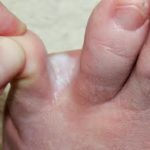 Because feet tend to be covered (at least partially) by shoes, they are sometimes neglected as a potential source of serious infection. From a distance feet may look acceptable however it is very important to pay attention to the spaces between the toes. These spaces are potential breeding grounds for germs.
Because feet tend to be covered (at least partially) by shoes, they are sometimes neglected as a potential source of serious infection. From a distance feet may look acceptable however it is very important to pay attention to the spaces between the toes. These spaces are potential breeding grounds for germs.
This post will talk about athletes foot: it’s features, people at risk, potential serious complications, and tips to prevent it.
Related post: Toenail fungus
Athletes foot may show up as mild flaking and peeling of the skin between the toes. In severe athletes foot, there are cracks in the skin and drainage of fluid. This weeping of fluid promotes continuous moisture and the skin between the toes becomes quite macerated. In severe cases there are deep painful cracks in the involved areas. The entire sole and sides of the foot may become involved.
Why are the spaces between the toes breeding grounds for germs? Because germs, particularly fungi (the cause of athletes foot), like warm, moist environments. If feet are not properly cleaned and dried every day, germs can overgrow and eventually invade the skin, causing infection.
Who is at risk for athletes foot?
Anyone can be affected by athletes foot, but it is more common in those who suffer from sweaty feet. People with uncontrolled diabetes are also at increased risk for athletes foot. Persistently high blood sugar levels in diabetics promotes overgrowth of yeast in their bodies.
When does athletes foot become a big problem?
A major complication of athletes foot comes when there is superimposed bacterial infection. Bacteria from the surface can get introduced into the cracks between the toes. Again, if the feet are not thoroughly washed on a regular basis, the bacteria can “brew” causing infection of the skin and underlying structures. Cellulitis occurs, and is characterized by redness, warmth, and pain of the skin, which may streak from the foot, up the leg.
Sometimes patients are puzzled as to why they keep getting cellulitis of their feet and legs. Close inspection often reveals untreated, previously unrecognized athletes foot.
Sometimes bacteria can get into a crack between 2 toes and burrow deep into the foot. The infection gets all the way down to bone, causing osteomyelitis. This is a serious problem because bone infections often require many weeks of antibiotics for a cure. Unfortunately, this is another complication that is seen commonly in uncontrolled diabetes.
Tips to prevent athletes foot
– Dry between each toe individually after a shower or bath.
– If prone to athletes foot, consider applying an anti fungal powder between toes after drying feet. If not a medicated anti fungal powder, any absorbent powder, for example corn starch, can be used. Depending on the amount of sweating of the feet, this powder may need to be applied more than once per day.
– Wear socks made from 100% natural fibers; natural fibers are more “breathable” and less likely to promote sweating of the feet. For any sweating that occurs, natural fibers are more absorbent. Cotton is a good fiber choice.
– Wear shoes made of natural materials – leather, natural fabrics. Like socks, shoes made of synthetic materials are not “breathable” and promote sweating of the feet.
– When able, wear open toed shoes, to enable feet/toes to “breath”.
– Inspect feet regularly, looking for evidence of cracked, macerated skin between the toes.
– If not able to see the spaces between toes, try to use a finger to feel the space. If there is moisture or pain, more attention is needed to the feet.
To conclude…
The feet should not be neglected in one’s quest to optimize health. Athletes foot is a common problem that is not only of cosmetic relevance, but may increase one’s risk for severe bacterial skin infections, and even infection of underlying bone. Prevention of athletes foot focuses on measures to keep the spaces between the toes dry. If infection arises, there is a variety of over the counter anti fungal treatments that may be used. More severe cases may need stronger medication prescribed by a doctor.
 Iza says
Iza says
May 12, 2016 at 12:26 pmIs BNT powder suitable for the treatment of athletes foot?
 infectiousmd says
infectiousmd says
May 17, 2016 at 11:44 amIza –
BNT ointment is an antibiotic powder containing the 3 antibiotics bacitracin, neomycin, and tyrothricin. Therefore it does not kill fungus causing athletes foot. Because it is a powder, if someone with a very mild case of athletes foot uses it, they might get some improvement just because the powder is keeping the space between their toes dry.
Thank you for your comment!
 Iza says
Iza says
June 17, 2016 at 6:12 pmThank You Doc!
 infectiousmd says
infectiousmd says
June 20, 2016 at 1:31 amYou are welcome Iza!
 Anonymous says
Anonymous says
May 13, 2016 at 9:15 pmTinactin ? Was a good choice for me. Completely cured my infection. Reoccurred twice, then no more. Hope this helps someone.
Darrel
 infectiousmd says
infectiousmd says
May 17, 2016 at 11:50 amYes…Tinactin is one of the available over the counter treatments for athletes foot. It is an anti fungal medication available as a spray, cream, and powder. For athletes foot, I recommend use of the powder because it helps to promote dryness. This medication is also used for fungal infections of the skin, such as in groin creases, etc. so the cream (and maybe spray) comes in handy for use in these areas.
Thank you for your comment Darrel!